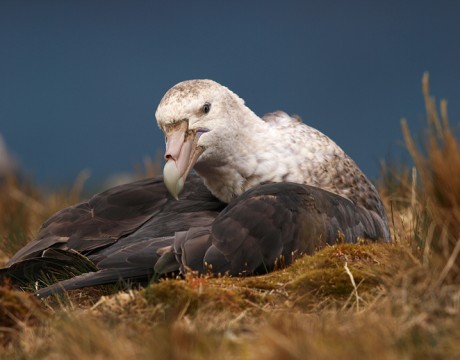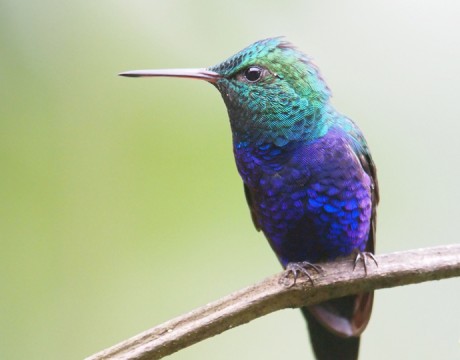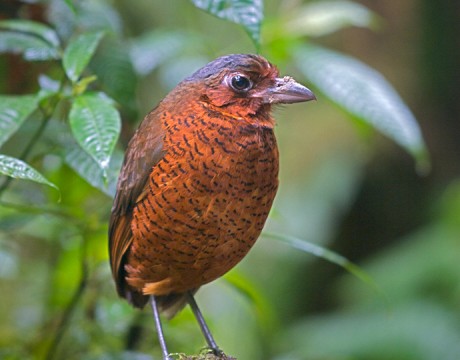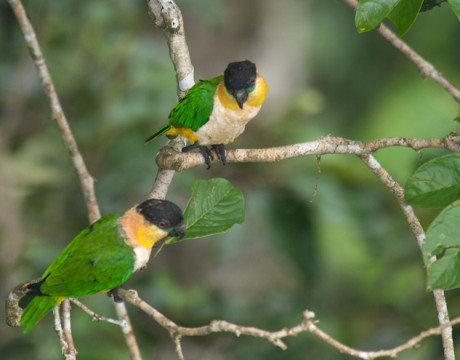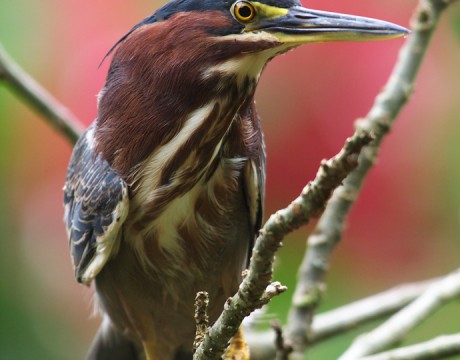Bird of the Week – Striated Caracara
The Striated Caracara is found in the Falkland Islands, in the far South Atlantic, east of the South America. It’s a member of the falcon family, but as often happens when a species reaches remote islands, it has expanded its ecological niche and acts more like a Common Raven. The locals call it “Johnny Rook.” Handsome, fearless and formerly common, it’s regarded as a threat to young and sick sheep by Falklanders. As a result, it’s badly persecuted, and the Falklands population is down to about 500 breeding pairs. The species is classified as “near-threatened.” For more bird images, please…
Bird of the Week – King Penguin
The King Penguin, after its for famous cousin, the Emperor, is the largest penguin on the planet. And, arguably, the most handsome. The bird on the right is the male; the two on the left are females. While it looks like a Three Musketeers routine, in fact the male is choosing a mate. This photo is from Elsehul, on the northwest end of South Georgia. For more bird images, please visit Frozen Feather Images.
Bird of the Week – Southern Giant Petrel
We’re still in the far south of the planet. This is a Southern Giant Petrel, a big, bad bird. Both a predator and a scavenger, it’s near the apex of the food chain in the South Atlantic Ocean. This is a “tube nose,” a bird adapted to living its life on salt water, coming ashore only to breed. The structure on top of her bill helps her to excrete salt in the water she drinks. She’s on eggs, and not especially happy about the big guy in the red coat. How big? A big female might weigh 18 pounds and have…
Bird of the Week – Rainbow Starfrontlet
One of the charms of hummingbirds is their marvelous names. This is a Rainbow Starfrontlet. Hummingbirds have extraordinarily long tongues, to get at the flower nectar that is their primary food. This female is showing you a part of her tongue. Technical stuff: tripod, f5.7, 1/250, ISO1250. For more bird images, visit Frozen Feather Images.
Bird of the Week – Violet-bellied Hummingbird
WC loves hummingbirds; their absence in Interior Alaska is a major drawback to an otherwise great place for birders. But it’s South America where hummingbirds really reach their peak in colors, populations and varieties. Perhaps you can agree with WC: a bird that looks like this is reason enough to visit South America; specifically, Ecuador. Technical stuff: tripod, f6.7, 1/250, ISO800. For more bird images, visit Frozen Feather Images.
Bird of the Week – Giant Antpitta
This is Maria, easily the most famous Giant Antpitta on the planet. Well, perhaps the only famous Giant Antpitta. She’s food-conditioned, and represents a great habitat conservation story. Antpittas are incredibly secretive, skulking on the jungle floor, in their cryptic feathers. Ordinarily getting even a glimpse of one is difficult. While they may look like a football on stilts, they run very quickly. Maria, not so much. Tech stuff: tripod, f2.8, 1/25, ISO800 (the jungle floor is quite gloomy) For more bird photos visit Frozen Feather Images.
Bird of the Week – Black-headed Parrot
Technically, it’s Birds of the Week this Saturday. These are Black-headed Parrots, photographed in Ecuador. And this is courtship behavior. The male is holding a tasty leaf in his left foot, offering it to the female. Spoiler alert! She wasn’t interested, and left a few seconds later. Leaving our disappointed suitor clutching and, eventually, eating the leaf. Tech stuff: Amazon jungle, along the Rio Napo, from a canopy tower. Tripod, f5.7, 1/250, ISO250. For more bird photos visit Frozen Feather Images.
Bird of the Week – Volcano Hummingbird
From a 39 inch bird, the Resplendent Quetzal last week, here’s a 3 inch bird, one-thirteenth the length of the Qutzel. This is the Volcano Hummingbird. This little guy lives at elevations of 6,000 feet and higher, up to the summits of the mountains and volcanoes of Costa Rica and Western Panama. This hummingbird species is found nowhere else in the world. Technical stuff: f7.1, 1/500th, ISO 400. For more bird photos, visit Frozen Feather Images.
Bird of the Week – Resplendent Quetzal
The Resplendent Quetzal would be on anyone’s short list of the most beautiful birds in the world. It is also Guatemala’s national bird. Unhappily for photographers, it’s a skulky species that likes the very dark under-canopy in cloud forests. And, yes, that’s really the bird’s tail, extending down out of the bottom of the frame. Technical stuff: 600mm lens, f5.7, 1/30, ISO400. More bird photos at Frozen Feather Images.
Bird of the Week – Green Heron
This Green Heron posed against a hillside of flowers. While Green Heron are fairly common in the Lower 48, this bird was photographed in Costa Rica, February 2013. This species hunts at the water’s edge, and is one of the few bird species that uses bait to attract prey. It’s coloration works surprisingly well as camouflage, especially from below. Technical stuff: 600mm lens, f5.7, 1/160, ISO400, tripod. More bird photos at Frozen Feather Images.







